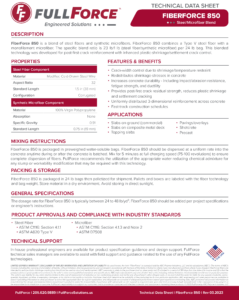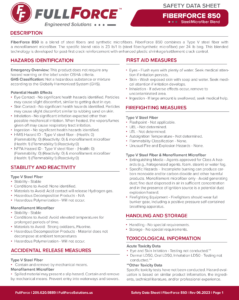FiberForce 850
General Information
FiberForce 850 is a blend of steel macrofibers and synthetic microfibers. FiberForce 850 combines a Type V steel macrofiber with a monofilament microfiber. The specific blend ratio is 23 lb/1 lb (steel macrofiber/synthetic microfiber) per 24 lb bag. This blended technology is developed for post-first crack reinforcement with enhanced plastic shrinkage/settlement crack control.
Additional Information
BATCHING
Truck Mixed (Dry Batched) Concrete
- Post-loading: FiberForce 850 fiber reinforcement is pre-packaged in24-lb. bags. Please note that the bags are not degradable. Bags of FiberForce 850 can be staged at the slump rack or on temporary scaffolding and added after all the standard ingredients have been thoroughly mixed with the drum revolving at mixing speed. They should be added in a continuous manner while the drum is revolving at mixing speed to ensure optimal distribution.
- Preloading (check with Justin and Ben): For truck-mixed concrete, the bags can be cut open and the loose fibers added into empty truck drums at the ready-mix plant followed by the coarse and fine aggregate, 1/3 to ½ of the mixing water, and then the remaining constituents so that the coarse aggregate can help break up the fiber.
Central Mixed (Wet Batched) Concrete
- Loading: Because typical central-mix plant configurations will limit the opportunity to add the fibers directly to the central mix drum, it is typically recommended to post-load the fibers after the concrete has been discharged into the truck as described above. Please refer to dry batch concrete loading options above. If there is an opportunity to add fibers into the central mix drum, please consult with your FiberForce Technical Sales Manager for the best mixing procedures for your project.
MIXING
When fibers are added directly to the truck (either preloading or post-loading), mix for 5 minutes at full charging speed (75-100 revolutions) to ensure complete, uniform fiber dispersion. Slower agitation speeds during transport to the site are insufficient for proper fiber dispersion and should not be counted toward the fiber mixing time. If fibers are added to central-mix drum, please discuss the appropriate mixing cycle length with your FiberForce Technical Sales Manager.
Check each truck for full dispersion of fibers prior to placement. If it appears that the fibers are balling, additional mixing at charge speed can help break up fiber balls.
Common causes of fiber balling:
- Truck drums with significantly worn-down blades have been used.
- Loose fibers can get hung up on rough loading chute of a truck mixer.
- The mixture is harsh with a high volume of coarse aggregate (more than 55% of the total combined aggregate by absolute volume) and not enough mortar.
- High volume percentages of steel synthetic fibers ( >0.33%) by volume have been used without compensating for the increased paste demand. FiberForce recommends the use of pre-construction trial mixes and the addition of a mid- to high-range water reducing admixture. Additional water should not be added as this could adversely affect the hardened concrete properties. For more information on adjusting the mix design of FRC, please see the Technical Bulletin titled “Mixture Proportioning for FRC.”
Get in touch
Physical address
Helena Industrial Park
545 Elm Street
Helena, AL 35080
Mailing address
P.O. Box 580
Helena, AL 35080
Send a message



